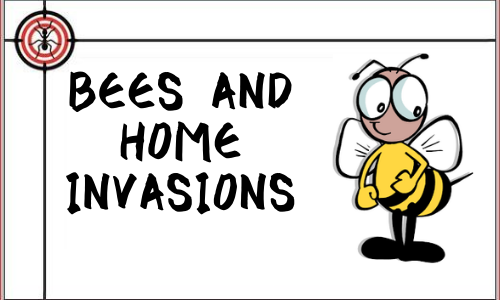There are three types of bees buzzing about your yard and home, one is most likely to cause harm to your home and need removal; one has been known to cause harm and needs specialized removal and one...wants to hang out with your flowers and isn’t interested in your home at all.
Bees, for reasons including the use of pesticides, loss of habitat and lack of native wildflowers, among others are on the decline. Although some bees make themselves overly familiar with your home, preserving bees still need to be a priority.

Eastern Carpenter Bees can do damage to your home as they bore into the wood to create nests. Carpenter bees do not bite. The female does have a stinger but will only use it if directly handled. While in a forest, carpenter bees would bore into older trees, a house will give them a similar nesting opportunity. They like unpainted wood, so painting more than staining wood, helps deter them. They do not chew the wood, instead they tunnel into it for nesting chambers.
The tell-tale signs are:
- Sawdust piles.
- Round holes about ½ an inch deep.
- The holes are usually located on the underside of wood surfaces like siding, overhangs, decks, fence posts, and fascia boards.

Inside where the tunneling occurs, there will be a network of hollowed pathways. Over the years the pathways can extend over 10 feet in length. The purpose of the pathways leads to nesting chambers so the female can lay eggs.
Eastern Carpenter bees are big, nearly an inch in size! Like the bumblebee it has black and yellow hairs, the abdomen though is shiny black.
These bees are not very social, live in in small related groups and stay in the same area for generations. While the males cannot sting, they will divebomb people or pets that come near.
Calling Victoria’s Pest Control to remove these bees will help regain the integrity of your home and the damage can be repaired.
Keeping Carpenter Bees at Bay:
- Paint the house.
- Fill a paper bag with plastic bags and string it up, carpenter bees are terrified of hornets and that bag will resemble a nest to them.
- Loud music is another deterrent as they dislike the vibrations.
If after protecting your home from re-infestation, there is an old shed or other unused wood on your property, remember that carpenter bees:
- Are pollinators for native plants, gardens and some trees.
- They visit flowers, feed on nectar, pick up pollen and disperse it.
- They are the sole pollinators of the passionflower.

Honey Bees are European natives that have lived here since the 1600’s. They are slender with wooly abdomens with bands of yellow to brown. They are about ½ an inch long. Honeybees are considered ‘social’ and live in large communal groups, between 20,000 to 40,000 bees.
They usually reside in hives, either in trees or man-made beehives structures for beekeeping. When the swarm decides a house is their new home, they often inhabit attics or spaces between walls. That communal group can number into the many thousands. They can also become aggressive and defensive. However, they will die upon stinging once, as the stinger is torn from their bodies.
It is ILLEGAL to kill honey bees!
Due to the honey-making likelihood of honey bees in your home, calling professionals is two-fold: to safely remove these bees and relocate them to a beekeeper’s frame and to seal up any entrances or crevices so they don’t come back.
Honeybees facts:
- It is the only insect that produces food eaten by humans
- Honeybees produce beeswax from eight paired glands on the underside of their abdomen
- They pollinate about 130 crops in the USA, including fruit, nut and vegetable crops as well as flowers
- A honeybee visits 50 to 100 flowers during a collection trip
- Honey bees communicate with one another by dancing


Bumblebees are social, generally live in small colonies in the ground or at the base of trees or under dead leaves. They are non-aggressive and are focused on flowers, not you or your home. They are pollinators and do produce honey but not in large amounts. They make honey by chewing the pollen and mixing it with their saliva.
Bees in all their forms are incredibly important to pollination of flowers and crops in New Jersey and the world. It is not that humans would die if there were no bees, but there would be a much smaller sampling of food as a result. And bees are dying. Here are some ways to help bees:
- Stop using pesticides, the poisons in these deterrents not only harm insects but also the environment, including the soil and waterways.
- Plant bee friendly gardens or allow part of your yard to be native wildflowers.
- Have a water feature in your yard, pollinating is thirsty work.
With Victoria’s Pest Control helping save your home from bees and having a bee friendly yard, you can have a bee-ti-ful summer!


Recent Comments